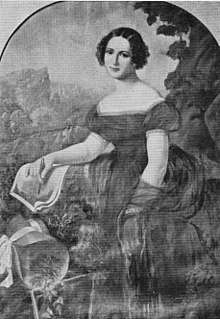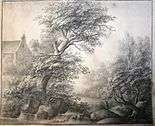Julie von Egloffstein
Julie von Egloffstein (September 12, 1792 – January 16, 1869), countess, canoness of Hildesheim, was a German artist, encouraged in her work by Johann Wolfgang von Goethe.
Julie von Egloffstein | |
|---|---|
 Self portrait | |
| Born | 12 September 1792 Erlangen, Germany |
| Died | 16 January 1869 (aged 76) Hildesheim, Germany |
| Nationality | German |
| Known for | Painting |
Life
She was born in Erlangen, daughter of Gottfried Friedrich Leopold Graf von und zu Egloffstein and his wife Henriette.[1]
She was one of the most beautiful and gifted women at the court of Weimar, and many of Goethe's poems bear witness to the lively interest which he took in her artistic development. She painted several portraits, including those of the Grand-Duchess of Saxe-Weimar and of Queen Theresa of Bavaria.[2]
In 1829-32 she toured Alsace, Switzerland and Italy, spending a considerable amount of time in Rome. She went to Italy again in 1838-40, visiting Sorrento, Naples and Rome.[1]
In addition to portraits, her works included Shepherds in the Roman Campagna (1835), Hagar in the Wilderness, The Exposure of Moses, Italian Popular Life and others, some of which were in the possession of the Emperor of Russia and of Queen Victoria.[2]
She died on January 16, 1869 at Marienrode.[1]
| Wikimedia Commons has media related to Julie Gräfin von Egloffstein. |
- Therese of Saxe-Hildburghausen, queen of Bavaria, 1836
 Landscape
Landscape August von Goethe, son of Johann Wolfgang von Goethe.
August von Goethe, son of Johann Wolfgang von Goethe.
See also
References
- "Egloffstein, Julie Gräfin von und zu" (in German). Archivdatenbank des Goethe- und Schiller-Archivs. Retrieved 27 July 2013.
- Bryan 1886
Sources
